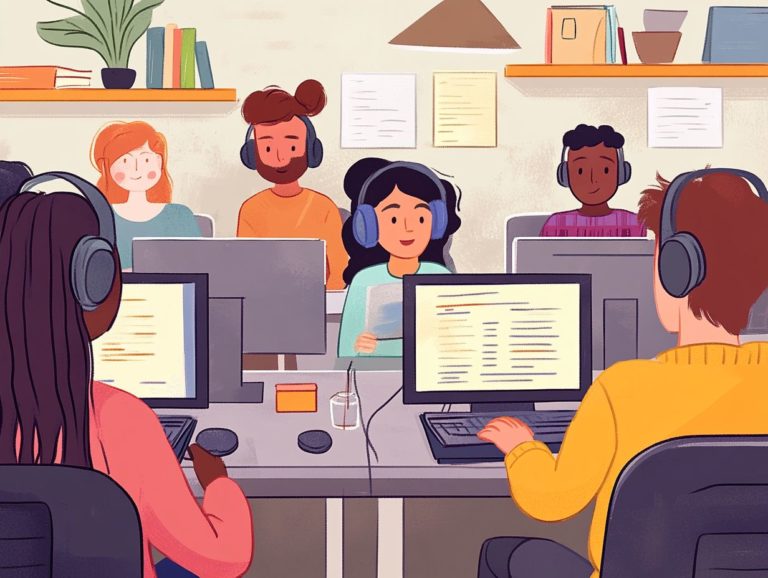the role of technology in language learning
Language learning has transformed significantly over the years. It has shifted from traditional methods to innovative technology that enhances your educational experience.
This exploration shows how technology enriches your language journey. You ll see benefits like greater engagement and access to diverse resources.
Challenges also exist, such as technical issues and impacts on your overall skills. Let s explore effective strategies for thriving in this evolving landscape.
Contents
- Key Takeaways:
- The Evolution of Language Learning with Technology
- Benefits of Technology in Language Learning
- Challenges and Limitations of Technology in Language Learning
- Incorporating Technology in Language Learning Curriculum
- Future of Technology in Language Learning
- Frequently Asked Questions
- Q1: What is the role of technology in language learning?
- Q2: How can technology be used in language learning?
- Q3: What are the benefits of using technology in language learning?
- Q4: Can technology replace traditional language learning methods?
- Q5: Are there any drawbacks to using technology in language learning?
- Q6: How can teachers use technology in language learning in the classroom?
Key Takeaways:

Technology has transformed language learning, offering engaging and personalized methods. It provides access to diverse resources that enhance your learning experience.
While technology has many benefits, it also presents challenges like technical difficulties that must be addressed in curriculum design.
The Evolution of Language Learning with Technology
The evolution of language learning has undergone a remarkable transformation in recent decades. It has moved away from conventional teaching methods toward the integration of new technology that enriches language acquisition and instruction.
With the rise of educational technology, you now have access to an abundance of digital resources. These include online platforms, multimedia content, and interactive exercises.
These tools not only facilitate effective language teaching but also actively engage you in the learning process.
This dynamic shift is revolutionizing how languages are taught and how you experience learning in real-world contexts. It offers personalized feedback and adaptive learning experiences that cater to your unique journey.
From Traditional Methods to Technology Integration
The shift from traditional language teaching methods to technology integration has transformed how you acquire language skills. This creates a more student-centered and interactive learning environment.
In traditional settings, you may have encountered rote memorization and one-size-fits-all approaches that often left you disengaged.
Thankfully, technology presents innovative solutions that enhance engagement and personalization. For example, software that helps you learn languages enables you to practice vocabulary and grammar at your own pace.
These programs offer instant feedback and tailor difficulty to your proficiency level. Moreover, mobile phones have become invaluable tools for language learning through applications that provide interactive exercises and opportunities for real-life practice, like language exchange platforms.
These resources deepen your understanding of the language and make the entire learning experience more enjoyable and dynamic.
Benefits of Technology in Language Learning
Technology brings incredible benefits to language learning! It actively fosters your engagement through interactive and gamified experiences, making the process effective and enjoyable.
You also gain access to many educational technology resources that significantly enhance your vocabulary building and language skills, enabling you to achieve fluency and confidence in your language journey.
Enhanced Engagement and Personalization
Enhanced engagement and personalization are significant benefits you ll experience when incorporating technology into your language learning journey. This approach offers tailored experiences that meet your unique needs as a language learner.
Consider platforms like Duolingo, which use adaptive learning algorithms to evaluate your proficiency in real-time. You can tackle specific challenges at your own pace, making the learning process more effective. With gamified elements, you ll find yourself motivated while receiving instant feedback on your progress.
Tools like Rosetta Stone take it a step further by using speech recognition technology, which allows the software to understand and evaluate your spoken language. This enables you to practice pronunciation and receive immediate corrections creating a truly interactive and enriching environment.
Case studies show that classrooms equipped with tools like Quizlet encourage collaborative learning through customized quizzes. This significantly enhances retention and understanding, particularly in diverse student groups. Learning becomes not just effective but also engaging.
Improved Access to Resources and Tools

Technology opens up amazing opportunities for language learners! You now have access to a vast range of resources and tools for language learning. With online platforms, engaging educational games, insightful podcasts, and chances to interact with native speakers at your fingertips, the world of language acquisition has never been more inviting.
These advancements allow you to immerse yourself in a language from various perspectives. For building your vocabulary, apps like Duolingo offer gamified lessons that keep you engaged through instant feedback and rewards.
Resources such as Rosetta Stone create immersive environments that reinforce your learning through context. This particularly benefits your listening and speaking skills.
Podcasts play an equally vital role, providing authentic conversations that help you grasp pronunciation and cultural nuances. These tools not only make learning more accessible but also customize experiences that align with your unique learning preferences.
Challenges and Limitations of Technology in Language Learning
While technology offers numerous advantages in language learning, you will encounter significant challenges and limitations that both educators and learners must navigate. These include tech glitches and a steep learning curve that complicate the process.
Technical Issues and Learning Difficulties
Tech glitches and learning difficulties tied to new language acquisition tools can present substantial challenges for you as both an educator and a student. These challenges often reveal themselves through software glitches, unresponsive interfaces, or confusing navigation paths. Such issues can lead to frustration and hinder progress.
The varying levels of technological literacy among teachers and learners can intensify these hurdles, resulting in disengagement and diminished motivation. To ensure a smoother transition, implement comprehensive training workshops for educators alongside user-friendly guides tailored for students.
Fostering a supportive online community where users can share tips and troubleshoot together can greatly enhance the overall experience, cultivating an environment of collaboration and perseverance.
Potential Detrimental Effects on Language Skills
Relying on technology for language learning can have unintended consequences on your language skills, particularly in areas like pronunciation and grammar, if approached carelessly. As you become more accustomed to using digital tools, the subtleties of proper speech and writing might start to fade away.
While automated pronunciation tools can be beneficial, they often provide only a surface-level understanding that lacks the richness of human interaction. Similarly, grammar-check software can lead you astray with misleading suggestions, encouraging a mentality that favors quick fixes over genuine understanding.
To truly excel in language mastery, combine traditional instructional methods like direct teacher feedback and active conversation practice with these digital resources. This way, you ensure that the crucial elements of language learning are preserved, even in our fast-paced, convenience-driven world. Don t miss out on the chance to enhance your language skills with these tools!
Incorporating Technology in Language Learning Curriculum
Incorporating technology into your language learning curriculum demands meticulous lesson planning and alignment with modern language methodologies.
This approach not only enriches the educational experience but also significantly enhances outcomes within educational institutions.
Effective Strategies and Best Practices

Implementing effective strategies and best practices in language teaching can significantly enhance the impact of EdTech solutions and collaborative platforms.
These strategies elevate the learning experience to new heights.
Start by integrating interactive tools that promote real-time communication and collaboration among students.
This fosters a more inclusive environment.
Incorporating gamification elements into your lessons can also spark motivation and stimulate engagement.
Imagine the excitement of learning through games!
Utilize digital platforms for formative assessments to track progress and adjust your instruction as needed.
This ensures that no student is left behind.
By embracing these innovative approaches, you can create a dynamic classroom atmosphere where learners feel enabled to explore their language skills confidently.
Future of Technology in Language Learning
The future of technology in language learning holds remarkable potential for developments that can revolutionize educational technology.
These advancements can elevate language proficiency among learners.
Embracing innovations will enhance the learning experience and enable greater fluency and mastery in your chosen languages.
Potential Developments and Impact on Education
Potential developments in technology, especially in voice recognition and computer-assisted learning, are set to significantly impact how you acquire language.
With innovations such as AI-driven language apps and immersive virtual reality environments, you ll find yourself in interactive settings that mimic real-life conversations.
These enhancements create engaging experiences and allow you to practice pronunciation and conversational skills in a risk-free environment.
Advancements in personalized learning technology adjust to help you learn better based on your needs.
As these technologies become more accessible, you may witness a transformation in educational methodologies.
This paves the way for tailored approaches that cater to your unique learning style and pace.
Frequently Asked Questions
Q1: What is the role of technology in language learning?
Technology plays a crucial role in language learning by providing various tools and resources that enhance language skills and facilitate the learning process.
Q2: How can technology be used in language learning?

Technology can be used in language learning through methods like language learning software, mobile applications, online courses, and virtual reality simulations.
Q3: What are the benefits of using technology in language learning?
The use of technology in language learning provides benefits such as increased engagement, personalized learning, and access to authentic resources.
It also offers convenient and flexible learning options.
Q4: Can technology replace traditional language learning methods?
No, technology cannot fully replace traditional methods as both have unique advantages.
However, technology can complement and enhance traditional methods to create a more effective learning experience.
Q5: Are there any drawbacks to using technology in language learning?
One potential drawback is the overreliance on technology, leading to a lack of human interaction and communication practice.
It’s important to balance technology use with real-life language practice.
Start exploring these tools today and transform your language learning journey!
Q6: How can teachers use technology in language learning in the classroom?
Teachers can use interactive whiteboards, educational apps, and online resources to enhance language learning.
Incorporating technology-based activities and projects into the curriculum makes lessons more engaging and helps students connect better with the material.






